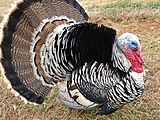Turkey breeds are reported to the DAD-IS breed database of the Food and Agriculture Organization of the United Nations by more than sixty countries.[1] The breeds reported include commercial/industrial strains, local types and recognised breeds in many countries.
United States
Twenty breeds are reported to DAD-IS by the United States.[2] Eight of them are recognised by the American Poultry Association in its breed standard, the American Standard of Perfection, where however they are classified as "varieties" rather than as breeds.[citation needed] This may be because the original genotype for domestic turkeys was for Bronze, and all other color varieties are due to mutations from it.[citation needed]
APA varieties
Europe
Twelve breeds are recognized by the Entente Européenne d'Aviculture et de Cuniculture.[5] Others with breed standards of European national associations are accepted.
EE breeds
| Variety (by National Standards)
|
Variety (colour)
|
country of origin
|
Comments
|
| American Blue (Slate Turkey) |
gray/blue |
USA |
|
| American Bronze |
Brown/Black base color with white near some of the turkey's feather tips. |
USA |
|
| American Black |
|
USA |
Pink legs and horn-colored beak. Spanish Black and Norfolk Black have black pigmented legs and beak.
|
| Beltsville Small White |
white |
USA |
|
| Dindon du Bourbonnais |
black |
F |
|
| Cambridge Bronze |
|
GB |
|
| Deutsche Pute |
|
D |
with EE-Standard of Perfection
|
| Deutsche Pute |
blue |
D |
|
| Bourbon Red |
D |
|
| Bronze |
D |
|
| Cröllwitzer |
D |
≈Royal Palm (USA)
|
| Buff |
D |
|
| Bronce |
D |
|
| narragansett coloured |
D |
|
| Red |
D |
|
| Red Winged |
D |
|
| Black |
D |
|
| Black Winged Bronze |
D |
|
| British white |
D |
|
| French turkey (Dindon) |
porcelan coloured |
F |
|
| Dindon du Gers |
schwarz |
F |
|
| Tacchino castano d'Italia |
|
I |
|
| Tacchino nero d'Italia |
black |
I |
|
| Pavo oscense |
black |
SP |
|
| Narragansett |
|
USA
|
| Norfolk Black Turkey |
|
GB
|
| Dindon de Ronquières |
fauve |
B |
|
| à épaulettes jaunes |
B |
≈Tricoloré du Colorado (F), ≈Sweetgrass (USA)
|
| jaspé |
B |
≈Royal Palm (USA), ≈Cröllwitzer (EE)
|
| perdrix |
B |
≈Krefelder Pute (D)
|
| White (blanc) |
B |
|
| Royal Palm |
black and white |
GB |
|
| Dindon rouge des Ardennes |
|
B/F |
a French breed, supposedly brought to Flanders in the 16th century from Mexico by the Spanish.
|
| Dindon de Sologne |
black |
F |
|
| Czech turkey (Česká krůta) |
Czech Wild White-braided Turkey (Divocezbarvené bíle lemované) |
CZ |
|
| šedědivocezbarvene bíle lemované |
CZ |
|
| White Holland |
|
USA |
|
| English Turkey |
buff |
E |
|
Other varieties not recognized by the APA or EE include the following:
- Auburn or Light Brown is an extremely rare as its numbers are not considered high enough for inclusion in the Standard. An extremely rare variant of the Auburn is called the Silver Auburn.
- Buff (or Jersey Buff) is a very rare heritage breed.
- Chocolate breed is chocolate brown in color. Day-old poults are white-faced with chocolate bodies.
- Midget White is a rare heritage breed sometimes confused with the Beltsville Small White.
- Zagorje (Zagorski puran) is a Croatian variant of turkey.






